Developer Guide
Table of Contents
- Acknowledgements
- Setting up, getting started
- Design
- Implementation
- Documentation, logging, testing, configuration, dev-ops
- Appendix: Requirements
- Appendix: Planned Enhancements
- Appendix: Instructions for manual testing
Acknowledgements
- https://github.com/poonchuanan/Python-PayNow-QR-Code-Generator was referred to for the format of PayNow QR codes as well as the CRC-16 algorithm.
Setting up, getting started
Refer to the guide Setting up and getting started.
Design
.puml files used to create diagrams in this document docs/diagrams folder. Refer to the
PlantUML Tutorial at se-edu/guides to learn how to create
and edit diagrams.
Architecture

The Architecture Diagram given above explains the high-level design of the App.
Given below is a quick overview of main components and how they interact with each other.
Main components of the architecture
Main (consisting of
classes Main
and MainApp) is
in charge of the app launch and shut down.
- At app launch, it initializes the other components in the correct sequence, and connects them up with each other.
- At shut down, it shuts down the other components and invokes cleanup methods where necessary.
The bulk of the app’s work is done by the following four components:
-
UI: The UI of the App. -
Logic: The command executor. -
Model: Holds the data of the App in memory. -
Storage: Reads data from, and writes data to, the hard disk.
Commons represents a collection of classes used by multiple other components.
How the architecture components interact with each other
The Sequence Diagram below shows how the components interact with each other for the scenario where the user issues
the command delete 1.

Each of the four main components (also shown in the diagram above),
- defines its API in an
interfacewith the same name as the Component. - implements its functionality using a concrete
{Component Name}Managerclass (which follows the corresponding APIinterfacementioned in the previous point.
For example, the Logic component defines its API in the Logic.java interface and implements its functionality using
the LogicManager.java class which follows the Logic interface. Other components interact with a given component
through its interface rather than the concrete class (reason: to prevent outside component’s being coupled to the
implementation of a component), as illustrated in the (partial) class diagram below.

The sections below give more details of each component.
UI component
The UI component has been enhanced with the addition of a new DisplayCard element. This element is responsible for
displaying the currently selected contact’s detailed information, enhancing the user experience by providing a more
interactive and comprehensive view of contact details.
The API of this component is specified
in Ui.java

The UI consists of a MainWindow that is made up of parts
e.g.CommandBox, ResultDisplay, PersonListPanel, StatusBarFooter etc, and the newly added DisplayCard.
All these, including the MainWindow, inherit from the abstract UiPart class which captures the commonalities
between classes that represent parts of the visible GUI.
The UI component uses the JavaFx UI framework. The layout of these UI parts are defined in matching .fxml files that
are in the src/main/resources/view folder. For example, the layout of
the MainWindow
is specified
in MainWindow.fxml
The UI component,
- executes user commands using the
Logiccomponent. - listens for changes to
Modeldata so that the UI can be updated with the modified data. - keeps a reference to the
Logiccomponent, because theUIrelies on theLogicto execute commands. - depends on some classes in the
Modelcomponent, as it displaysPersonobject residing in theModel.
Logic component
API : Logic.java
Here’s a (partial) class diagram of the Logic component:

The sequence diagram below illustrates the interactions within the Logic component, taking execute("delete 1") API
call as an example.

DeleteCommandParser should end at the destroy marker (X) but due to a limitation of PlantUML, the lifeline continues till the end of diagram.
How the Logic component works:
- When
Logicis called upon to execute a command, it is passed to anAddressBookParserobject which in turn creates a parser that matches the command (e.g.,DeleteCommandParser) and uses it to parse the command. - This results in a
Commandobject (more precisely, an object of one of its subclasses e.g.,DeleteCommand) which is executed by theLogicManager. - The command can communicate with the
Modelwhen it is executed (e.g. to delete a person).
Note that although this is shown as a single step in the diagram above (for simplicity), in the code it can take several interactions (between the command object and theModel) to achieve. - The result of the command execution is encapsulated as a
CommandResultobject which is returned back fromLogic.
Here are the other classes in Logic (omitted from the class diagram above) that are used for parsing a user command:

How the parsing works:
- When called upon to parse a user command, the
AddressBookParserclass creates anXYZCommandParser(XYZis a placeholder for the specific command name e.g.,AddCommandParser) which uses the other classes shown above to parse the user command and create aXYZCommandobject (e.g.,AddCommand) which theAddressBookParserreturns back as aCommandobject. - All
XYZCommandParserclasses (e.g.,AddCommandParser,DeleteCommandParser, …) inherit from theParserinterface so that they can be treated similarly where possible e.g, during testing.
Directly executing commands without user input:
- The application has instances where some function might be performed on a button click instead of a user input.
- In such cases, the flow bypasses the need to parse a user input, and we directly pass a
Commandobject into theLogicclass to be executed.
The following sequence diagram illustrates how the components interact with each other when a user clicks on a button to
reset the debt they have with a specific Person.
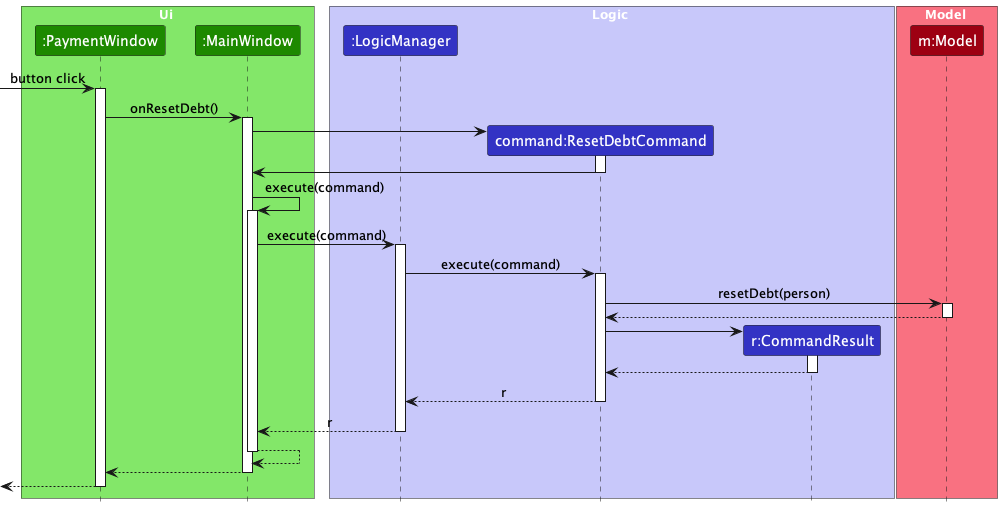
Model component
API : Model.java

The Model component,
- stores the address book data i.e., all
Personobjects (which are contained in aUniquePersonListobject). - stores a separate sorted list of
Personobjects (e.g., results of a sort query) which is then used to construct the filtered list below - stores the currently ‘selected’
Personobjects (e.g., results of a filter query) as a separate filtered list which is exposed to outsiders as an unmodifiableObservableList<Person>that can be ‘observed’ e.g. the UI can be bound to this list so that the UI automatically updates when the data in the list change. - stores a
UserPrefobject that represents the user’s preferences. This is exposed to the outside as aReadOnlyUserPrefobjects. - does not depend on any of the other three components (as the
Modelrepresents data entities of the domain, they should make sense on their own without depending on other components)
Tag list in the AddressBook, which Person references. This allows AddressBook to only require one Tag object per unique tag, instead of each Person needing their own Tag objects.
Storage component
API : Storage.java

The Storage component,
- can save both address book data and user preference data in JSON format, and read them back into corresponding objects.
- inherits from both
AddressBookStorageandUserPrefStorage, which means it can be treated as either one (if only the functionality of only one is needed). - depends on some classes in the
Modelcomponent (because theStoragecomponent’s job is to save/retrieve objects that belong to theModel)
Common classes
Classes used by multiple components are in the seedu.addressbook.commons package.
Implementation
This section describes some noteworthy details on how certain features are implemented.
Filter feature
Introduction
FriendFolio can filter contacts by tags, days available (in a week) and by name using FilterCommand.
FilterCommand can also specify whether the filter is any-match or all-match with respect to the keywords using
the --all flag (it is by default any-match).
Note that the --all flag is implemented using ArgumentMultimap, and it must be placed at the end of the command,
for example:
filter tag friends colleagues --all
Any text after --all is not parsed, but will produce the same result as the above command instead of throwing an error.
Implementation
To reduce code duplication, the abstract FilterCommand extracts identical methods of 3 commands
(FilterNameCommand, FilterTagCommand, FilterDayCommand). Each command now inherits execute from FilterCommand,
and has their own error message and command specific information. The filter feature is implemented as follows:
- The
filtercommand syntax is parsed by FilterCommandParser, where the type of filter (e.g. by tags, days available (in a week) or name) and the--allflag are parsed to create the respective Predicates. - The created Predicates are used to instantiate their respective FilterCommands which inherit
executefrom the abstract FilterCommand class. - The common
executefunction modifies theObservableList<Person>in theModelcomponent to show the newly-filtered list.
The sequence diagram below shows how the components interact with each other when the user enters the command filter tag friend.
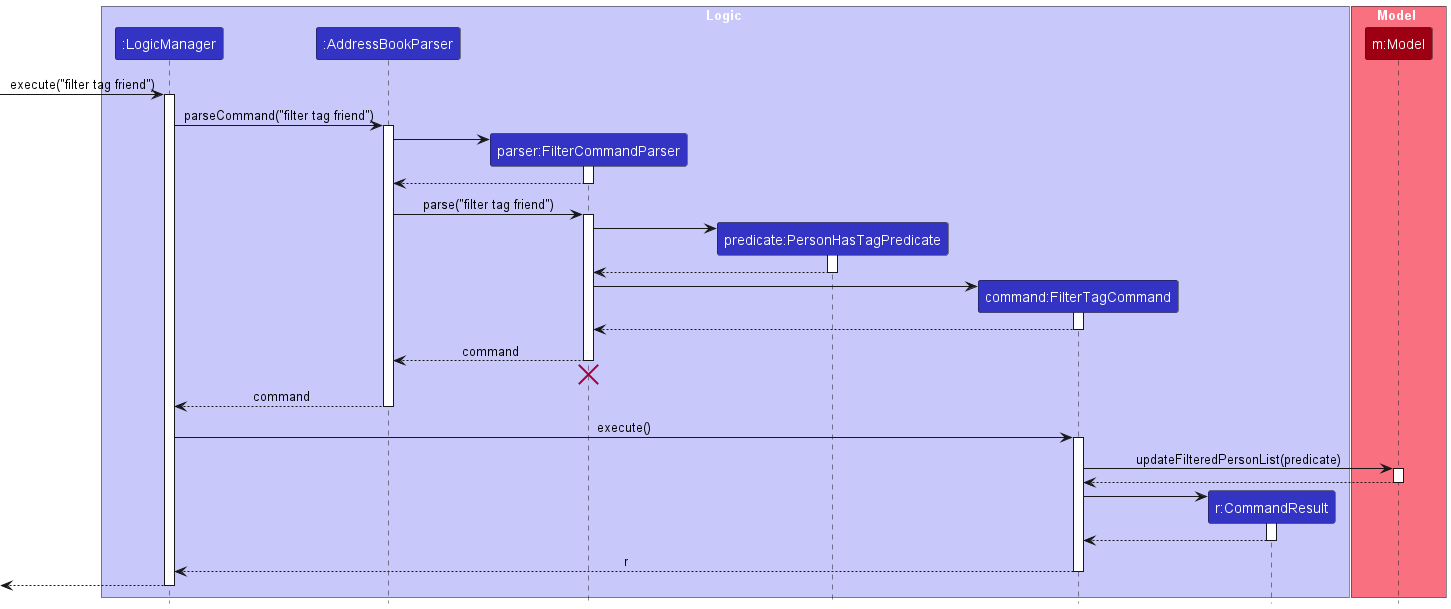
FriendFolio Predicates
Predicates in FriendFolio take in both a list of keywords to match, and a boolean to handle the all-match condition.
There are currently 3 predicates: NameContainsKeyWordPredicate, PersonAvailableOnDayPredicate, PersonHasTagPredicate.
Alternatives Considered
- Single FilterCommand Class: Initially considered using a single FilterCommand class to handle every specified filter type (day, name, tag). This approach was discarded because it is less extensible and OOP.
- FilterCommand as an Interface: This approach was discarded because of near-identical method logic across FilterNameCommand, FilterTagCommand and FilterDayCommand which meant significant code-duplication.
UML Diagram
Refer to the below class diagram to visualize the relationships between FilterCommand, commands inheriting from FilterCommand and predicates.

Remark Command
Introduction
The Remark Command allows users to add or remove remarks for a person in the address book. This feature enhances the app’s usability by enabling users to store additional information about a contact that doesn’t fit into the standard fields like name, phone, or email.
Implementation
The RemarkCommand is implemented in the following steps:
- The user inputs a command in the format remark
INDEX r/REMARK, whereINDEXis the position of the person in the current list, andREMARKis the new remark for the person. - The AddressBookParser parses the input and creates a new
RemarkCommandobject. TheRemarkCommandexecutes by:- Retrieving the person to edit from the model based on the index.
- Creating a new Person object with the updated remark and other details unchanged.
- Replacing the old person object in the model with the updated one.
- The UI is then updated to display the person’s details with the new remark.
This implementation ensures that the app’s performance is unaffected by the addition of remarks, as it reuses the existing infrastructure for modifying person details.
Alternatives Considered
- Storing Remarks Separately: Initially considered storing remarks in a separate map with the Person as the key. This approach was discarded because it complicated the model’s state management and increased the risk of data inconsistency.
- Extending Person Model: Another option was to extend the Person model to include remarks as a mandatory field. However, this was not ideal as remarks are optional and should not affect the creation of Person objects.
UML Diagram
To illustrate the interaction between components for the remark command, a sequence diagram is provided:
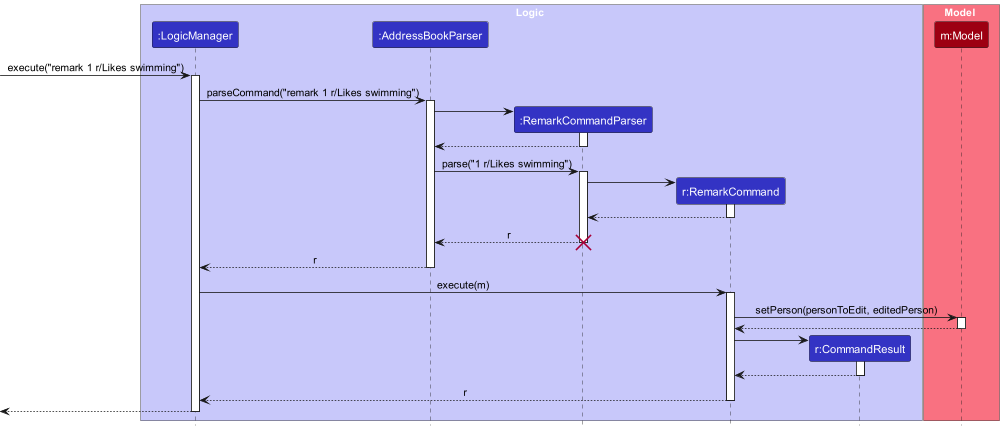
Lend Command
Implementation Overview
After the AddressBookParser identifies that the user’s input is calling the lend command word, it creates a
LendCommandParser. The LendCommandParser then parses the user’s input and creates a new LendCommand
containing one Index. The LendCommand is then executed by LogicManager, which updates the
MoneyOwed attribute in Person. A CommandResult which stores the message of the outcome of lend command is
then returned. Part of the class diagram is shown below.
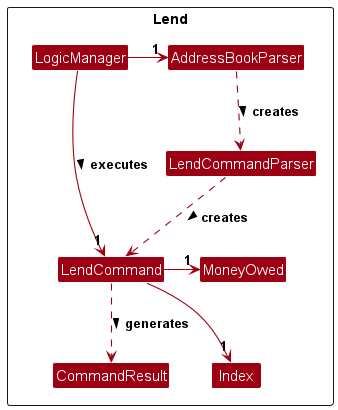
When the LendCommand executes, it checks if the Index is valid based on the last displayed list.
If it is valid, the MoneyOwed of the target person will be updated with the new amount.
The following activity diagram sums up the workflow of what happens when the user keys in a lend command.
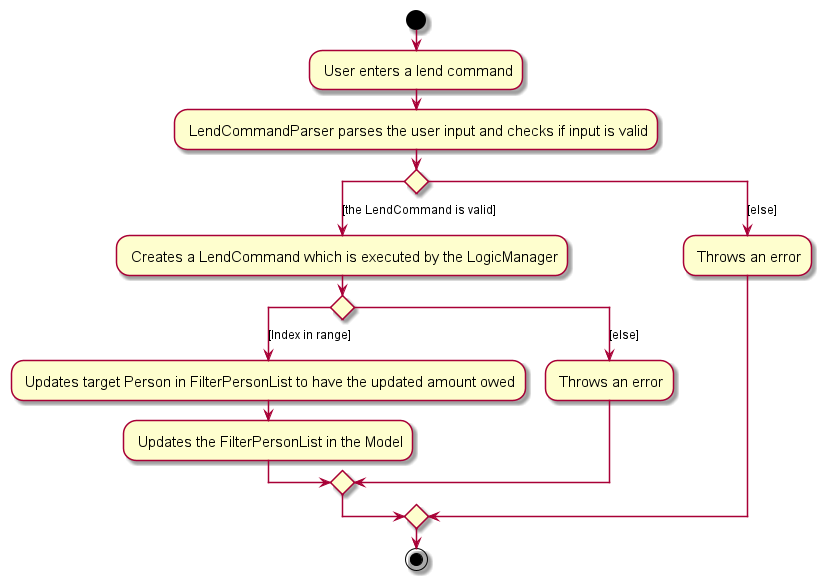
Split Command
Implementation Overview
After the AddressBookParser identifies that the user’s input is calling the split command word, it creates a
SplitCommandParser. The SplitCommandParser then parses the user’s input and creates a new SplitCommand
containing one MoneyOwed object with the amount to split and at least one Index. The SplitCommand is then
executed by LogicManager, which updates the MoneyOwed attribute in Person. A CommandResult which stores
the message of the outcome of split command is then returned. Part of the class diagram is shown below.
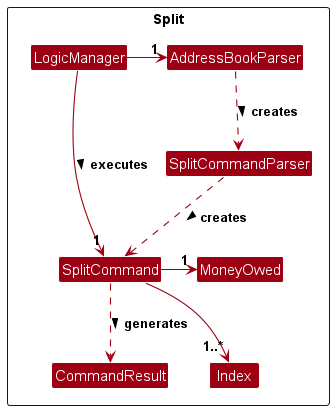
The following activity diagram sums up the workflow of what happens when the user keys in a split command.
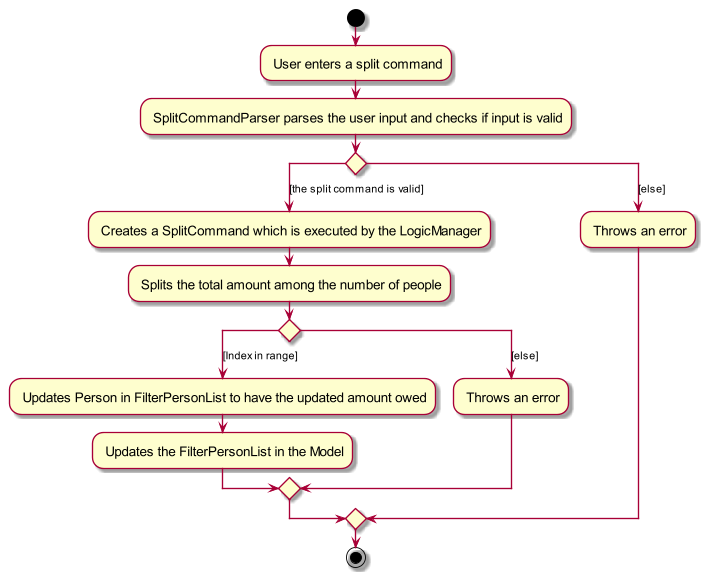
This implementation considers the user as an active participant in the split. For example, when the user enters two indexes, the total amount is evenly divided among the user and the two specified individuals.
Alternatives Considered
- Implementing unequal splits of money owed among contacts. However, this approach would necessitate manual
calculations and the input of specific values for each contact, thereby undermining the primary advantage of the
split command — to simplify and automate the distribution process. For scenarios requiring specific, manually
determined amounts, users can utilize the
lendcommand, which is designed for financial entry for a single contact.
PayNow
PayNow QR codes are basically encoded string, further encoded into a QR code. The string follow a specific format and can be generated offline. The specifications of the format have been referenced from this repo.
Basically, the string represents an object (similar to JSON) and it contains “fields” (similar to JSON attributes). In one of the required fields is a nested object.
The class diagram is as such:
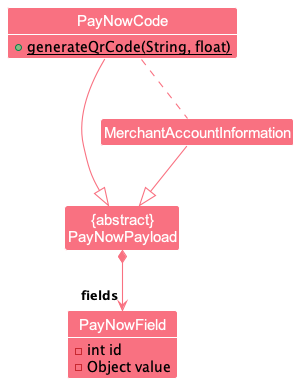
PayNowPayload is the aforementioned representation of an object. One PayNowPayload can contain
multiple PaynowFields.
PayNowCode is what we encode into the QR code that we can then scan. One of the fields contain
a MerchantAccountInformation, which is also a PayNowPayload itself (which is the nested object that had been
mentioned above).
We then call PayNowCode’s static method, passing in a phone number and an initial amount (that will be autofilled when users scan the QR code with their banking application), to generate the QR code.
Sort Command
FriendFolio can sort contacts in 4 different ways:
- Name
name - Money Owed
money - Closest upcoming birthday
birthday - Time they were added into FriendFolio (Default)
clear
For example: sort name
We use a SortedList to facilitate dynamic sorting by allowing the updating of a Comparator. This enables users to toggle between various sorting methods seamlessly.
This SortedList is then used in the constructor of a FilteredList which is used in the implementation of the filter feature.
The FilteredList is then used by the UI to display the contacts in the specified order and filters because any changes in the ordering of the contacts from the SortedList will be propagated to the FilteredList, which will then reflect in the GUI.
For the first 3 sort types, a static Comparator<Person> is implemented inside the respective classes themselves (e.g. Name, MoneyOwed, Birthday).
When executing the command, the model will call the updatePersonComparator inside the Model class. A null is passed in as the comparator if sort clear is executed.
The sequence diagram below shows how the components interact with each other when the user enters the command sort name.
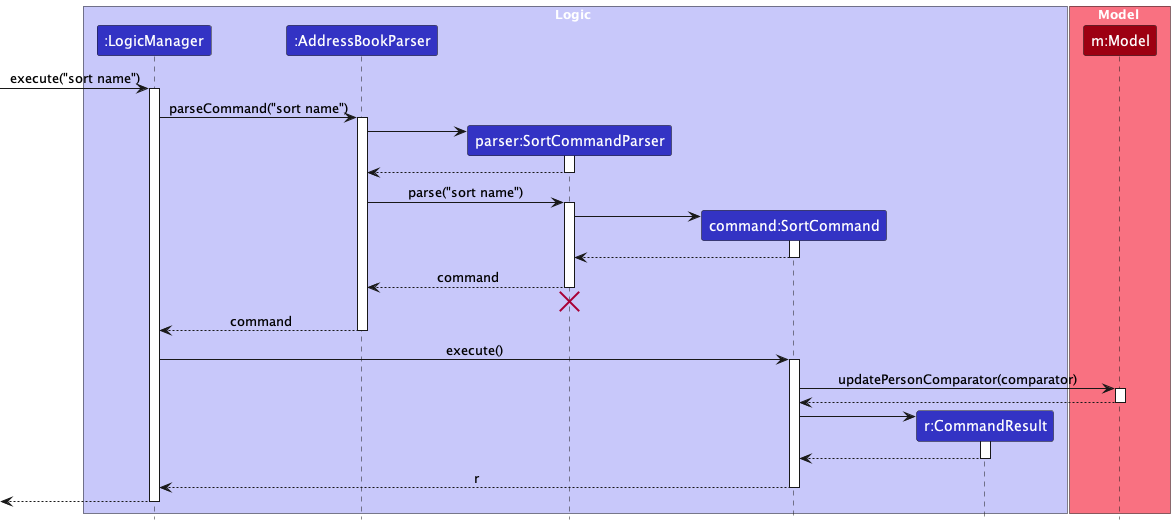
Home Page UI
Overview
HomeCard is a new feature in the UI component designed to provide users with a quick overview of crucial information immediately upon application launch. It serves as a dynamic dashboard, displaying the current date and time, the total number of contacts, a summary of financial transactions, and a list of contacts available for the day.
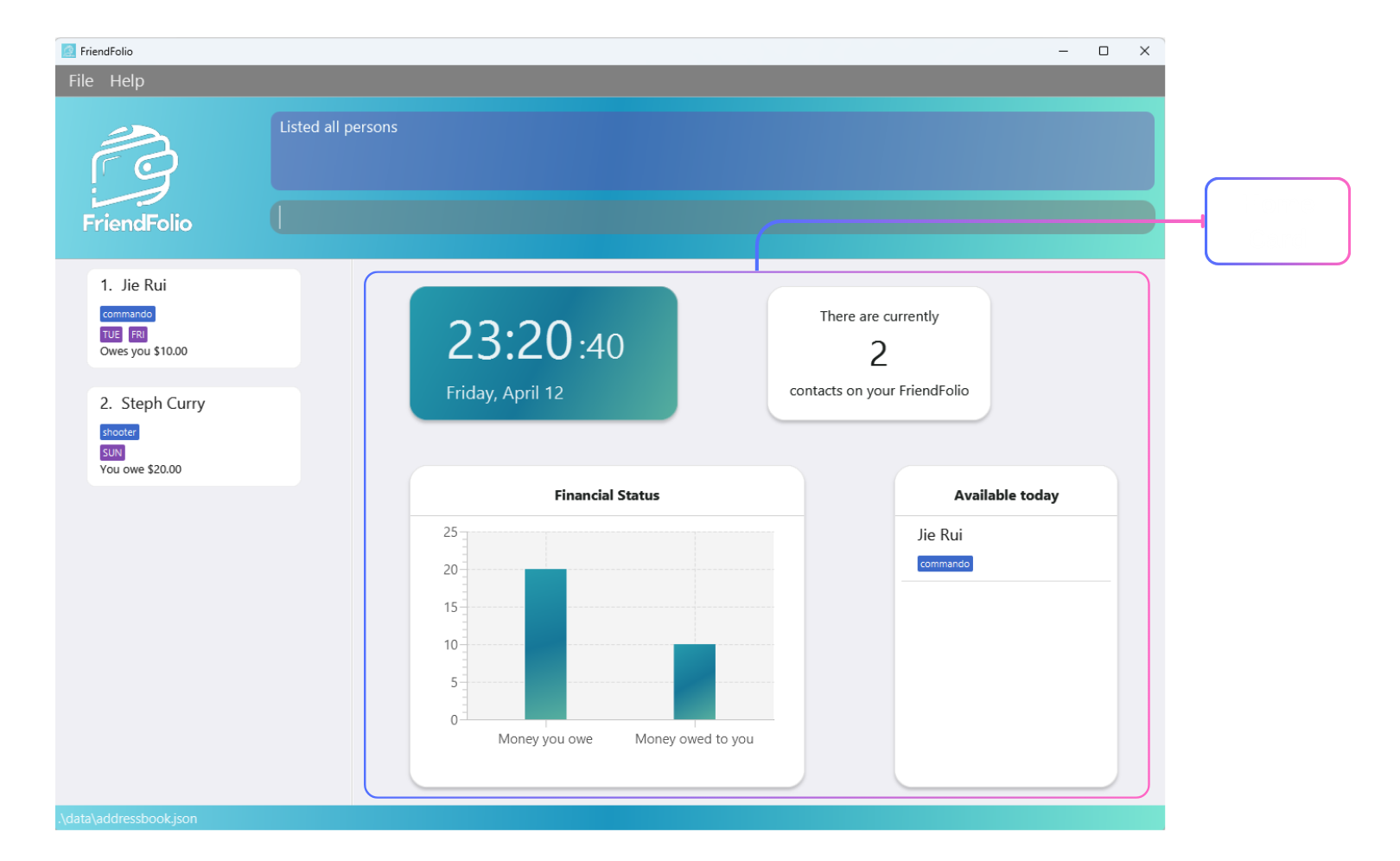
Implementation
The HomeCard is implemented using JavaFX and is integrated into the main window of the application. It interacts directly with the Model component to fetch real-time updates, ensuring that all displayed information reflects the latest data.
Key features include:
-
Real-Time Clock: Utilizing Java’s
LocalDateTimeandTimelineto update every second. - Contact Counter: Dynamically updates as contacts are added or removed.
-
Financial Overview: Uses a
BarChartto graphically display money owed and owing. - Availability List: Shows contacts available today based on their schedules.
Detailed Design
The layout for HomeCard is defined in HomeCard.fxml, organized to provide immediate access to its features, which are essential for enhancing user interaction and providing a comprehensive view at a glance.
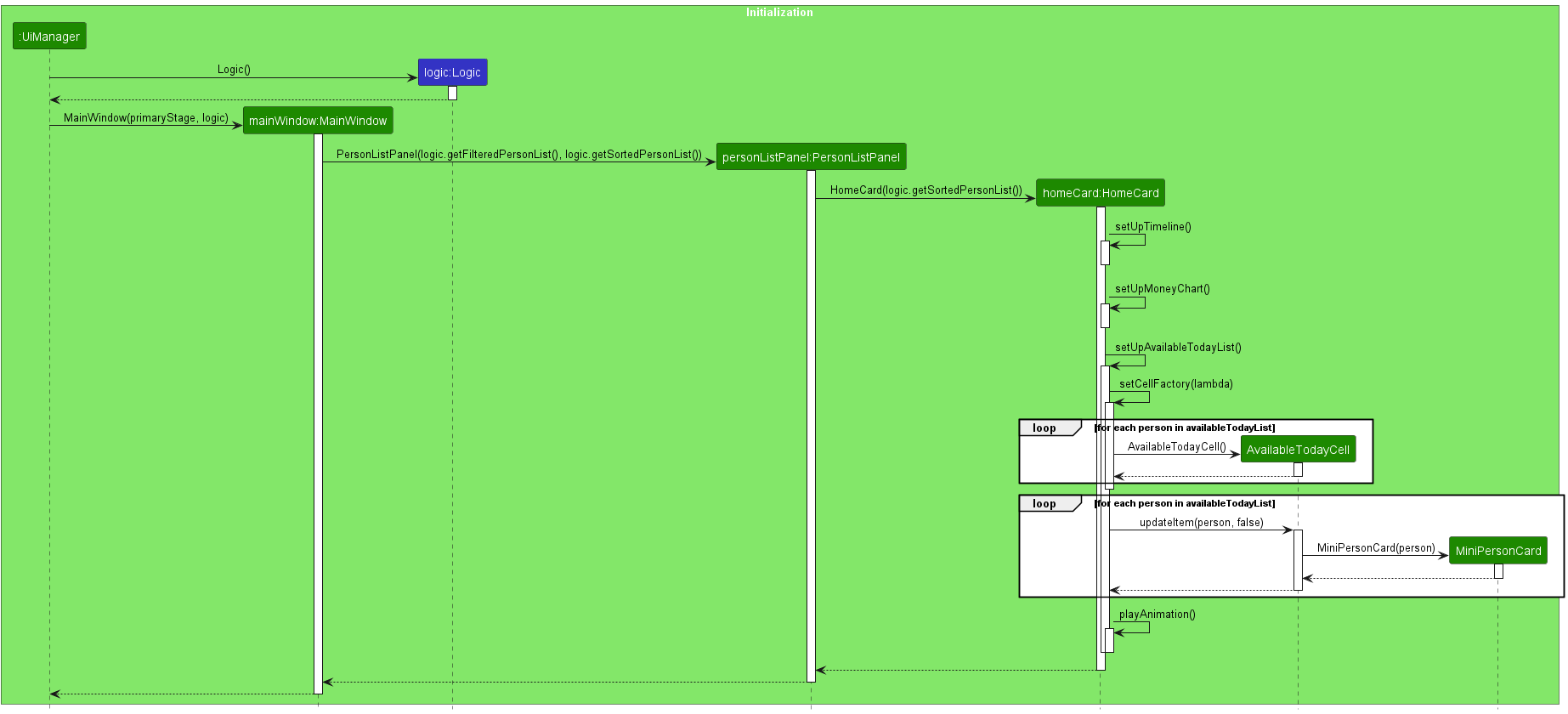
MiniPersonCard component
Overview
Embedded within the HomeCard, the MiniPersonCard serves as a compact display module for contacts available on the current day. It offers a quick snapshot of essential contact details, enhancing the HomeCard functionality by allowing users to identify key information swiftly.
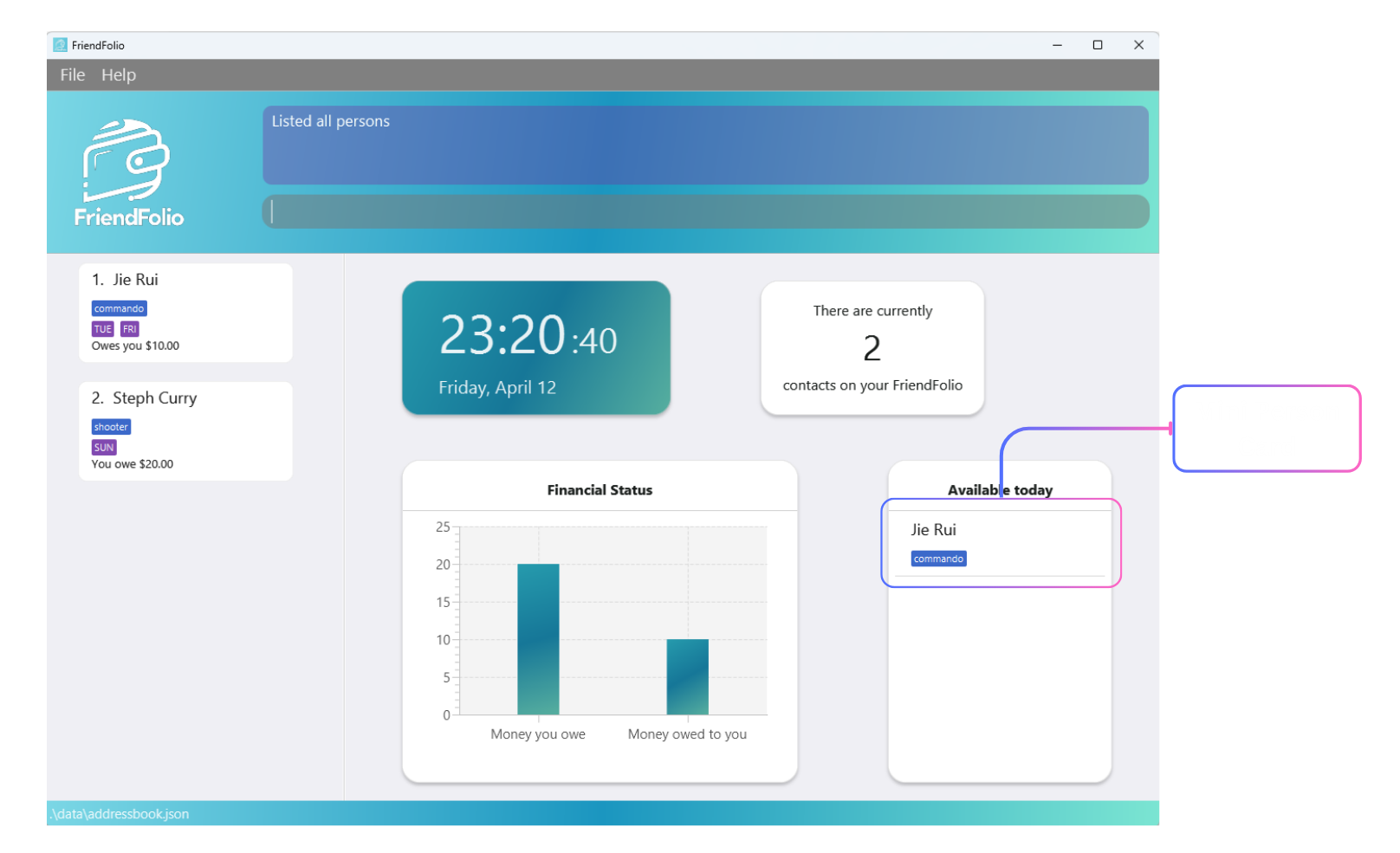
Functionality
Each MiniPersonCard represents an individual contact, showcasing brief but pertinent details such as the contact’s name and their availability status. This component is utilized in the ListView of the HomeCard to enumerate all contacts who are available today.
Design
Like DisplayCard, MiniPersonCard is built using JavaFX and defined in MiniPersonCard.fxml. The design is minimalistic, focusing on displaying only the most relevant information to maintain the streamlined nature of the HomeCard’s overview purpose.
Integration into HomeCard
MiniPersonCard integrates seamlessly into the HomeCard to provide a dynamic list that updates daily, showing which contacts are available based on their schedules. This integration is crucial for users who need to quickly assess their contacts’ availability without navigating away from the home screen.
DisplayCard component
Overview
The DisplayCard enhances the UI by providing detailed information about a selected contact. This component is designed to improve user interaction by offering a more comprehensive and interactive view of contact details.
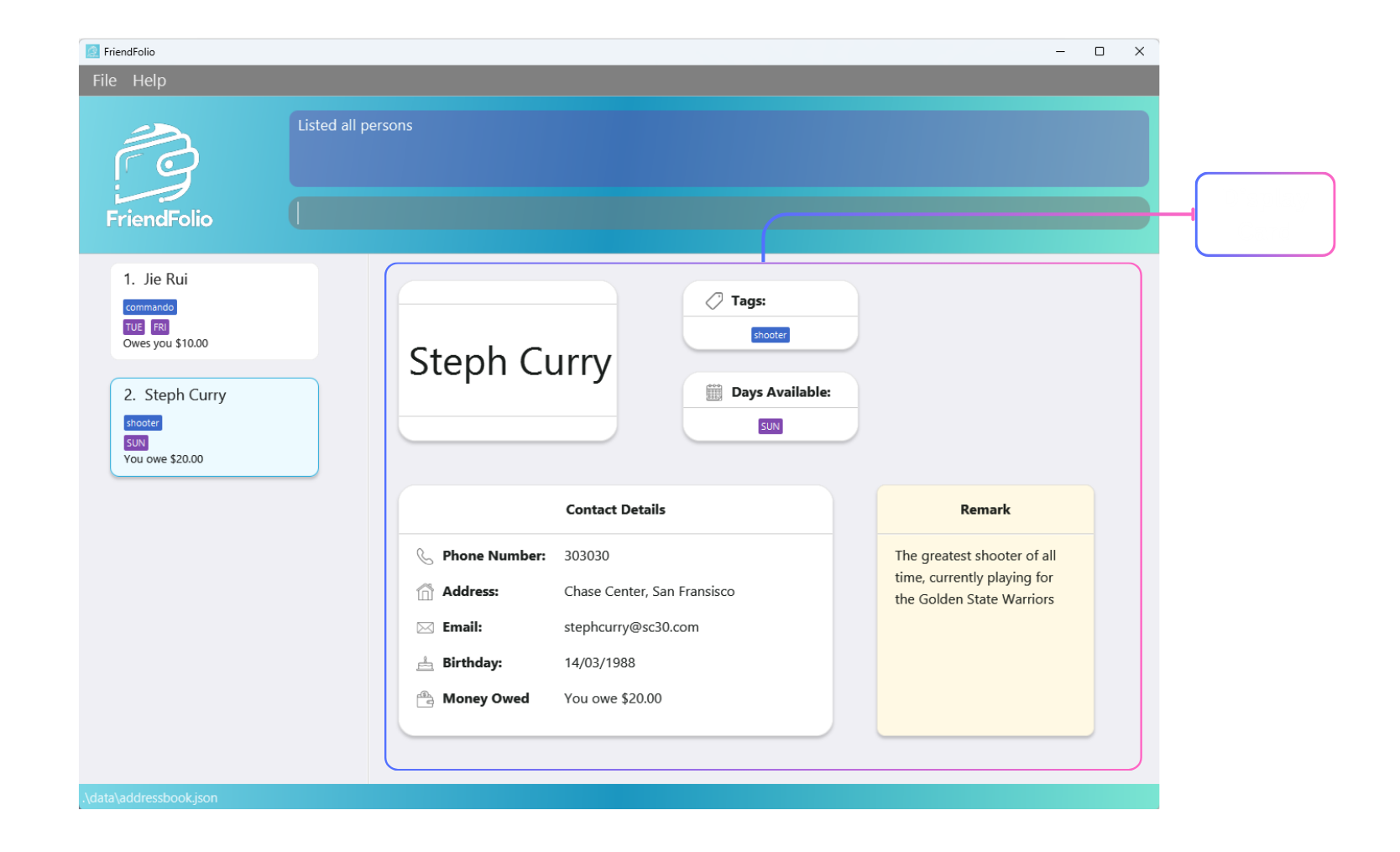
Functionality
DisplayCard is responsible for displaying extensive details about a contact, such as name, tags, birthday, and other personal details like debt or remarks. It updates in real-time when users select different contacts within the application.
Design
The implementation of DisplayCard relies on JavaFX, and its layout is managed via DisplayCard.fxml. It subscribes to updates from the Model component to ensure the displayed information is always current, reflecting any changes made to the contact information immediately.
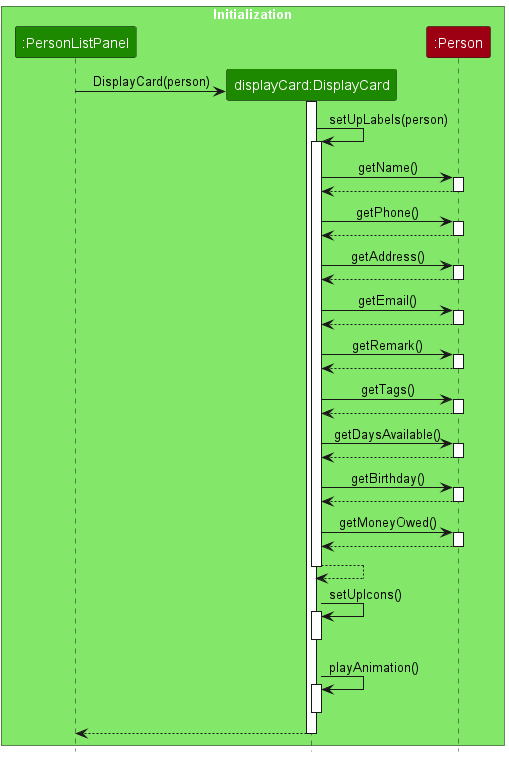
[Proposed] Undo/redo feature
Proposed Implementation
The proposed undo/redo mechanism is facilitated by VersionedAddressBook. It extends AddressBook with an undo/redo
history, stored internally as an addressBookStateList and currentStatePointer. Additionally, it implements the
following operations:
-
VersionedAddressBook#commit()— Saves the current address book state in its history. -
VersionedAddressBook#undo()— Restores the previous address book state from its history. -
VersionedAddressBook#redo()— Restores a previously undone address book state from its history.
These operations are exposed in the Model interface as Model#commitAddressBook(), Model#undoAddressBook()
and Model#redoAddressBook() respectively.
Given below is an example usage scenario and how the undo/redo mechanism behaves at each step.
Step 1. The user launches the application for the first time. The VersionedAddressBook will be initialized with the
initial address book state, and the currentStatePointer pointing to that single address book state.
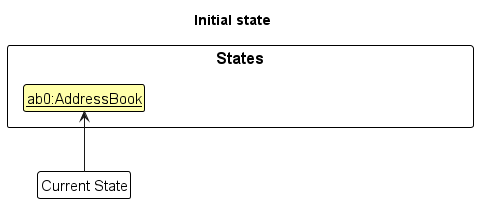
Step 2. The user executes delete 5 command to delete the 5th person in the address book. The delete command
calls Model#commitAddressBook(), causing the modified state of the address book after the delete 5 command executes
to be saved in the addressBookStateList, and the currentStatePointer is shifted to the newly inserted address book
state.
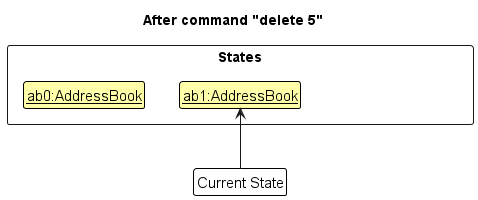
Step 3. The user executes add n/David … to add a new person. The add command also
calls Model#commitAddressBook(), causing another modified address book state to be saved into
the addressBookStateList.
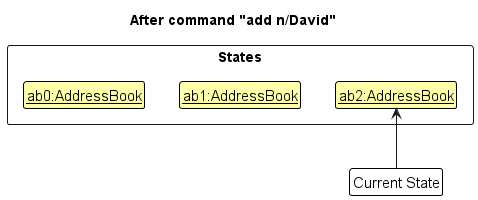
Model#commitAddressBook(), so the address book state will not be saved into the addressBookStateList.
Step 4. The user now decides that adding the person was a mistake, and decides to undo that action by executing
the undo command. The undo command will call Model#undoAddressBook(), which will shift the currentStatePointer
once to the left, pointing it to the previous address book state, and restores the address book to that state.
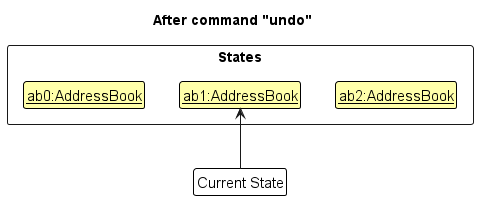
currentStatePointer is at index 0, pointing to the initial AddressBook state, then there are no previous AddressBook states to restore. The undo command uses Model#canUndoAddressBook() to check if this is the case. If so, it will return an error to the user rather
than attempting to perform the undo.
The following sequence diagram shows how an undo operation goes through the Logic component:

UndoCommand should end at the destroy marker (X) but due to a limitation of PlantUML, the lifeline reaches the end of diagram.
Similarly, how an undo operation goes through the Model component is shown below:
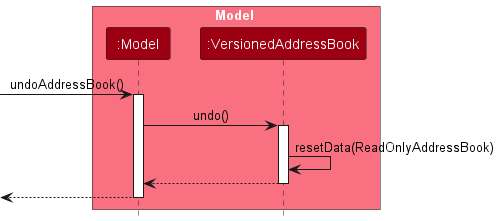
The redo command does the opposite — it calls Model#redoAddressBook(), which shifts the currentStatePointer once
to the right, pointing to the previously undone state, and restores the address book to that state.
currentStatePointer is at index addressBookStateList.size() - 1, pointing to the latest address book state, then there are no undone AddressBook states to restore. The redo command uses Model#canRedoAddressBook() to check if this is the case. If so, it will return an error to the user rather than attempting to perform the redo.
Step 5. The user then decides to execute the command list. Commands that do not modify the address book, such
as list, will usually not call Model#commitAddressBook(), Model#undoAddressBook() or Model#redoAddressBook().
Thus, the addressBookStateList remains unchanged.
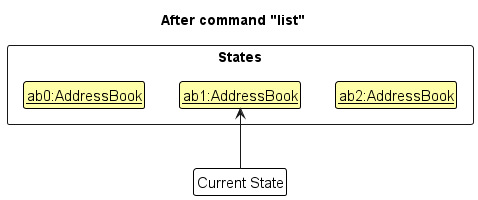
Step 6. The user executes clear, which calls Model#commitAddressBook(). Since the currentStatePointer is not
pointing at the end of the addressBookStateList, all address book states after the currentStatePointer will be
purged. Reason: It no longer makes sense to redo the add n/David … command. This is the behavior that most modern
desktop applications follow.
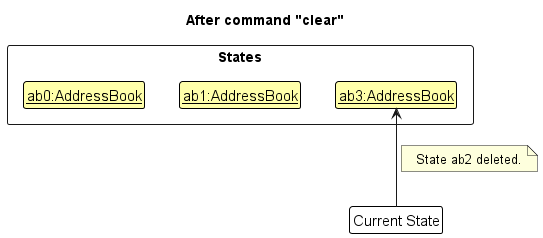
The following activity diagram summarizes what happens when a user executes a new command:
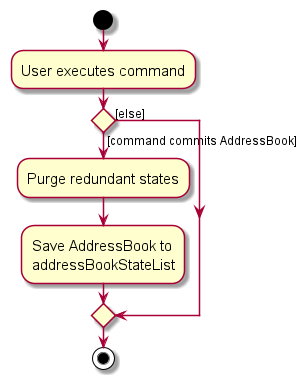
Design considerations:
Aspect: How undo & redo executes:
-
Alternative 1 (current choice): Saves the entire address book.
- Pros: Easy to implement.
- Cons: May have performance issues in terms of memory usage.
-
Alternative 2: Individual command knows how to undo/redo by
itself.
- Pros: Will use less memory (e.g. for
delete, just save the person being deleted). - Cons: We must ensure that the implementation of each individual command are correct.
- Pros: Will use less memory (e.g. for
{more aspects and alternatives to be added}
[Proposed] Data archiving
{Explain here how the data archiving feature will be implemented}
Documentation, logging, testing, configuration, dev-ops
Appendix: Requirements
Product scope
Target user profile:
NUS students who want to coordinate weekly meetup sessions for meals/activities
- has a need to manage a significant number of contacts
- prefer desktop apps over other types
- can type fast
- prefers typing to mouse interactions
- is reasonably comfortable using CLI apps
- would like to know who is available on a particular day of the week
- would like to know how much he owes to/is owed by his contacts
Value proposition: FriendFolio tailors the contact management experience just for students. It streamlines connections, enhances academic collaborations, and fosters a vibrant community within their reach. FriendFolio elevates the networking game, making every interaction meaningful.
User stories
Priorities: High (must have) - * * *, Medium (nice to have) - * *, Low (unlikely to have) - *
| Priority | As a … | I want to … | So that I can… | Notes |
|---|---|---|---|---|
* * * |
new user | see usage instructions | refer to instructions when I forget how to use the App | |
* * * |
user | add a new person | ||
* * * |
user | delete a person | remove entries that I no longer need | |
* * * |
user | find a person by name | locate details of persons without having to go through the entire list | |
* * * |
user | view person’s information | ||
* * |
user | hide private contact details | minimize chance of someone else seeing them by accident | |
* * |
user | store days that my contacts are in school | see who is free to meet up | |
* * |
user | store the phone numbers of our contacts | be able to call our contacts | |
* * |
user | store address | be able to visit them | |
* * |
user | store tags | be able to store miscellaneous information about them | |
* * |
user | store email | email them | |
* * |
user | store money owed | remember who owes me money | |
* * |
forgetful user | store birthdays of my contacts | not forget when their birthdays are | |
* * |
user | store uncategorized information under a field | remember other information that may not be captured in the existing list of fields | “newton doesn’t eat beef” |
* * |
user | edit person’s information | correct mistakes made when I added the contact | |
* * |
user with many persons in the address book | sort persons by name | locate a person easily | |
* |
user | filter contacts by tags | find contacts of specific categories such as family, friends | |
* |
user | update money owed | ||
* |
user | sort contacts by money owed | look at who owes me the most money | |
* |
user | sort contacts by birthdays | remember to wish the person for his birthday | |
* |
user | be able to split bills easily | I can efficiently manage my expenses and accurately track who owes what | |
* |
user | filter contacts by days that my contacts are in school | see who is free to meet up more easily | |
* |
user | be warned of creating contacts with duplicate phone numbers | to avoid making duplicate contacts | |
* |
user | share/export my contacts | back them up or share them with others | |
* |
user | store profile pictures of my contacts | quickly identify and remember my contact | |
* |
user | see what is the total amount owed to me/i owe to my contacts | start paying up/ asking others to pay stuff for me | |
* |
experienced user | use quick keyboard shortcuts to perform all the implemented functions above | use the address book more efficiently | |
* |
new user | input contact information into multiple separate input fields (instead of entering one command) | i can avoid making mistakes by not being familiar with the command format | |
* |
user | pin starred contacts at the top of the address book | quickly access my favorite contacts | |
* |
user | access my search history on the search bar | quickly access recent searches | |
* |
user | store incomplete contacts as drafts | return to my incomplete contacts to finish them up after any disruption without losing existing keyed-in information | |
* |
user | access my desired contacts via autocomplete in the search bar | efficiently access my contacts in the address book | |
* |
experienced user | add multiple contacts with one input | efficiently use the address book | |
* |
user | remove starred contacts from the top of the address book | remove contacts i no longer want to pin |
{More to be added}
Use cases
(For all use cases below, the System is the AddressBook and the Actor is the user, unless specified
otherwise)
Use Case: Add Contact
Preconditions: User is logged into the system.
MSS
- User selects the option to add a new contact.
- User enters the contact’s name, phone number, and any other optional information.
- System validates the provided information.
- System adds the new contact to the address book.
- System displays a confirmation message.
Postconditions: A new contact is added to the address book.
Alternate Flows: If the information fails validation, the system notifies the user and requests correct data.
Use Case: Delete Contact
Preconditions: User is logged into the system and the address book contains at least one contact.
MSS
- User requests a list of contacts and selects one to delete.
- System requests confirmation for deletion.
- User confirms.
- System deletes the selected contact from the address book.
- System displays a confirmation message.
Postconditions: The selected contact is removed from the address book.
Alternate Flows: If the user cancels the deletion, no action is taken.
Use Case: Edit Contact
Preconditions: User is logged into the system and the address book contains at least one contact.
MSS
- User requests to edit a contact and selects one from the list.
- System displays the selected contact’s current information.
- User updates the necessary information.
- System validates the updated information.
- System updates the contact details in the address book.
- System displays a confirmation message.
Postconditions: The selected contact’s information is updated in the address book.
Alternate Flows: If the updated information fails validation, the system notifies the user and requests correct data.
Use Case: Store Phone Number
Preconditions: User has initiated adding or editing a contact.
MSS
- User provides a phone number for the contact.
- System validates the phone number format.
- System stores the phone number with the contact’s information.
Postconditions: The contact’s phone number is stored or updated.
Use Case: View Contacts
Preconditions: User is logged into the system.
MSS
- User selects the option to view contacts.
- System retrieves and displays all contacts from the address book.
Postconditions: User views the list of all contacts in the address book.
Use Case: Store Address
Preconditions: User has initiated adding or editing a contact.
MSS
- User provides an address for the contact.
- System validates the address format.
- System stores the address with the contact’s information.
Postconditions: The contact’s address is stored or updated.
Use Case: Store Tags
Preconditions: User has initiated adding or editing a contact.
MSS
- User provides one or more tags for the contact.
- System stores the tags with the contact’s information.
Postconditions: The contact’s tags are stored or updated.
Use Case: Store Email
Preconditions: User has initiated adding or editing a contact.
MSS
- User provides an email address for the contact.
- System validates the email format.
- System stores the email with the contact’s information.
Postconditions: The contact’s email address is stored or updated.
Use Case: Store Money Owed
Preconditions: User has initiated adding or editing a contact.
MSS
- User provides an amount of money owed for the contact.
- System validates the money format.
- System stores the money owed information with the contact’s details.
Postconditions: The contact’s money owed information is stored or updated.
Use Case: Store Birthday
Preconditions: User has initiated adding or editing a contact.
MSS
- User provides a birthday for the contact.
- System validates the birthday format.
- System stores the birthday with the contact’s information.
Postconditions: The contact’s birthday is stored or updated.
Use Case: Store Remarks
Preconditions: User has initiated adding or editing a contact.
MSS
- User provides some remarks for the contact.
- System stores the remarks with the contact’s information.
Postconditions: The contact’s remarks are stored or updated.
Extensions
-
2a. The list is empty.
Use case ends.
-
3a. The given index is invalid.
-
3a1. AddressBook shows an error message.
Use case resumes at step 2.
-
{More to be added}
Non-Functional Requirements
- Should work on any mainstream OS as long as it has Java
11or above installed. - Should be able to hold up to 1000 persons without a noticeable sluggishness in performance for typical usage.
- A user with above average typing speed for regular English text (i.e. not code, not system admin commands) should be able to accomplish most of the tasks faster using commands than using the mouse.
- Should remain functional in the event that the user types in an invalid command.
{More to be added}
Glossary
- Mainstream OS: Windows, Linux, Unix, MacOS
- Private contact detail: A contact detail that is not meant to be shared with others
Appendix: Planned Enhancements
-
Making Phone Number and Email Address Unique
The current FriendFolio system uses a contact’s name as a unique identifier. We are planning to enhance this by switching to using contact’s phone number and email as unique identifiers. This change will prevent multiple individuals from sharing the same email or phone number within the system, while allowing the existence of multiple individuals with the same name.
-
Improved responsiveness of GUI for long text
We are aware that excessively long text, like long names, addresses, and remarks etc. might not display fully in a smaller window. While you are able to make the window larger to display more text, we plan to work on improving the responsiveness of our user interface to handle longer inputs.
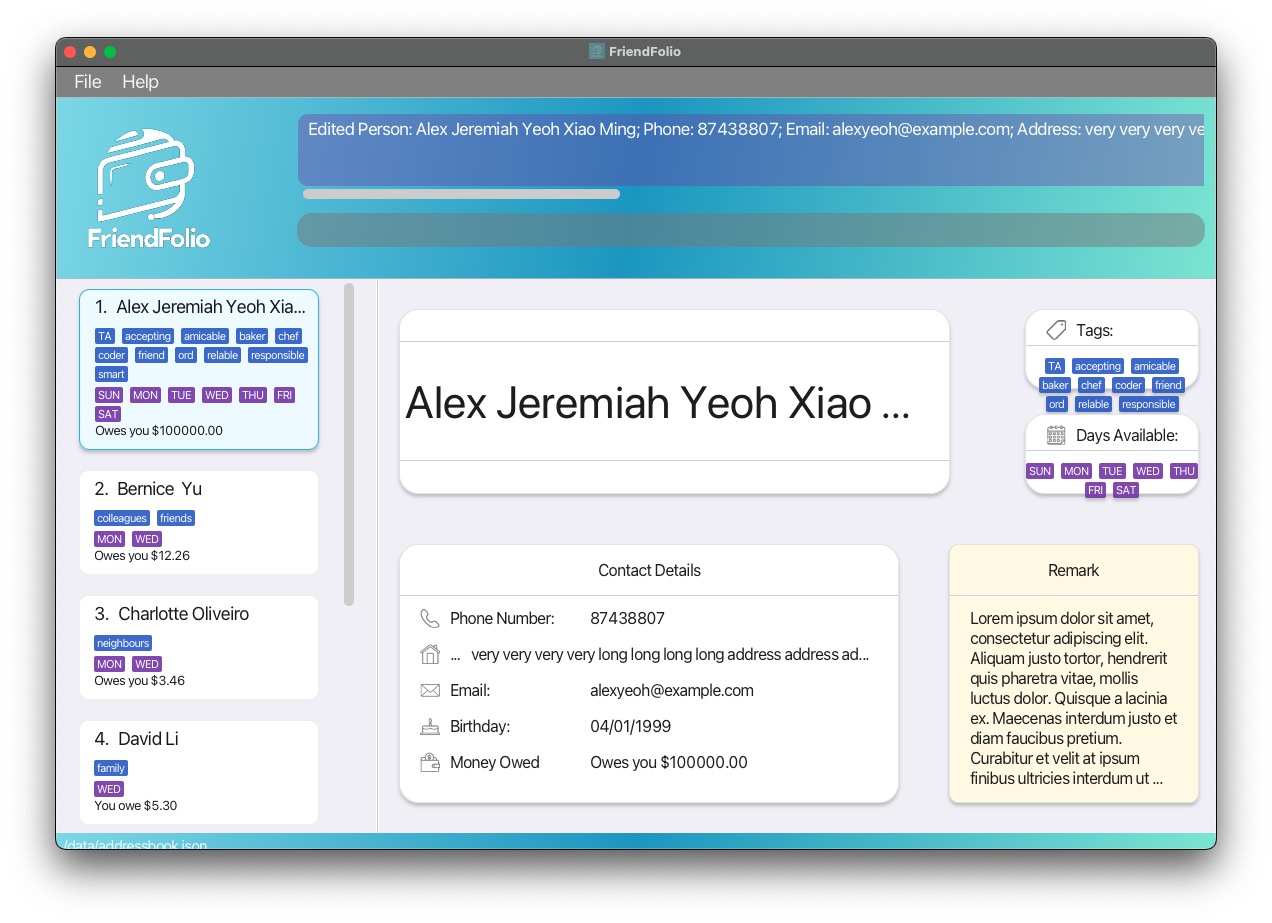
-
Improved responsiveness of GUI for different screen sizes
We are aware that some UI components like the display card, overlap with other components when the screen size is reduced. We plan to enhance the responsiveness of our application to ensure it dynamically adapts and supports various display sizes seamlessly in the future.
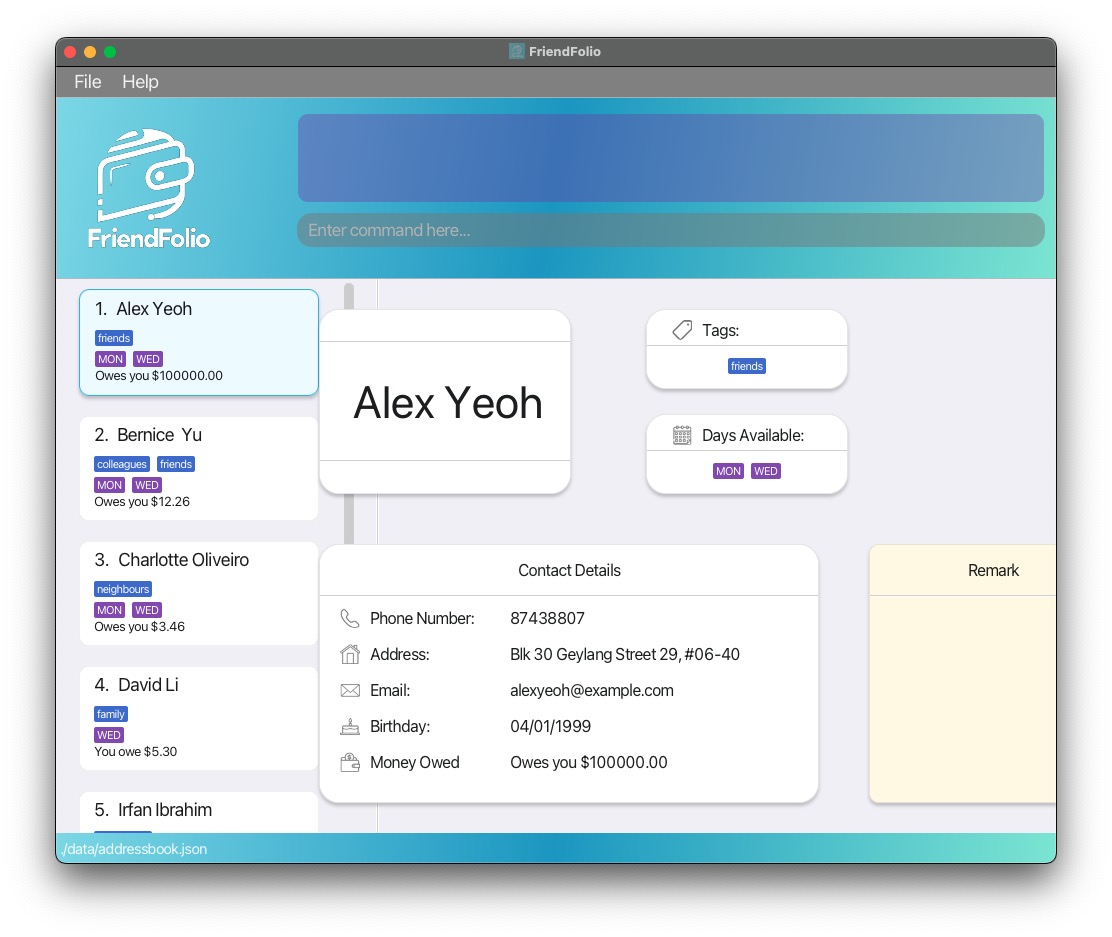
-
Maintain information of GUI for different screen sizes
We are aware that when the screen size is reduced, some information from the contact details card may get cut off. We plan to address this issue by enhancing the responsiveness of our interface in future updates, ensuring that all information remains visible and accessible on smaller screens.
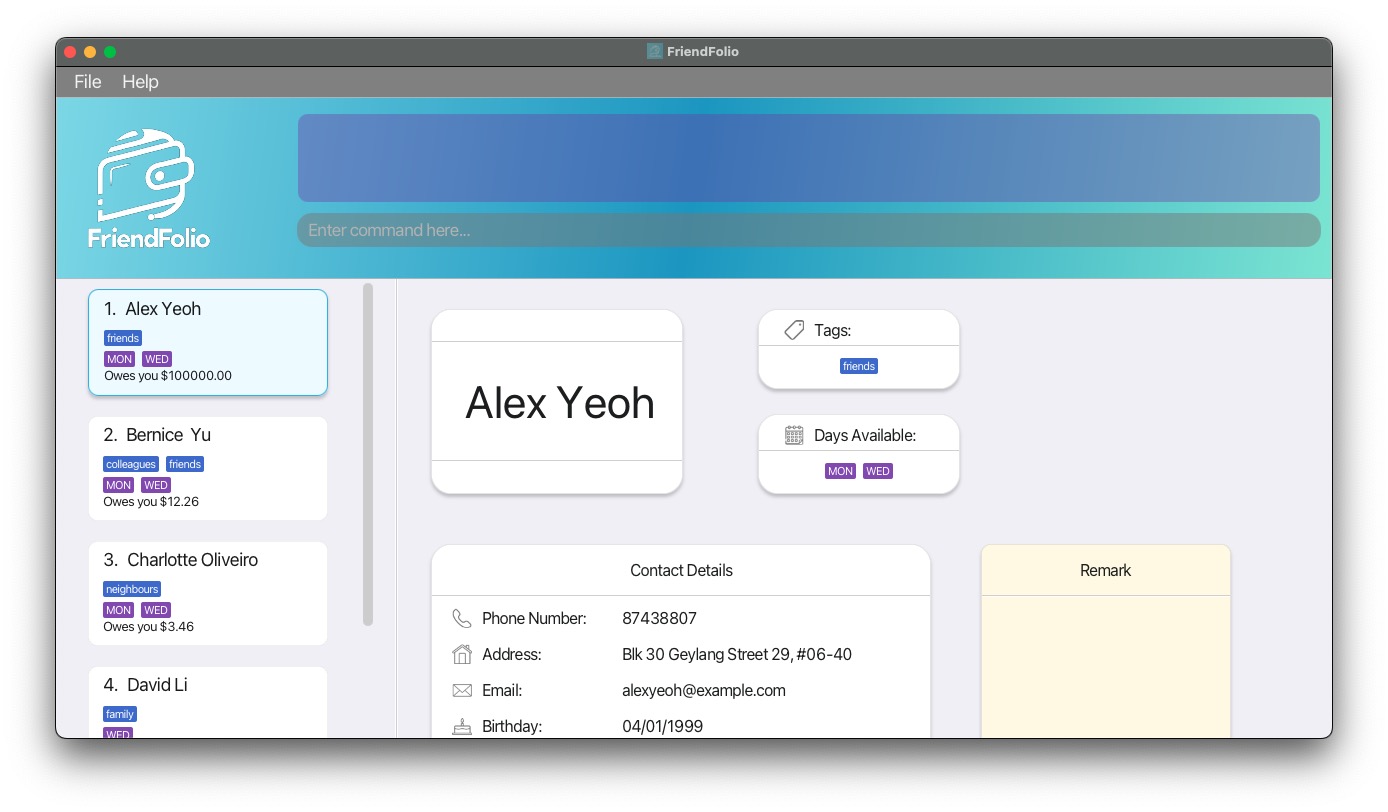
-
Improve messages to user
We are aware that some of our error and success messages could be more informative for our users. For example, the current success message for edit and add command does not display information on birthday, money owed and days available. We plan to enhance these messages to provide more specific information, ensuring a better user experience.
-
Use of symbols in names
Our application currently supports only alphanumeric characters in names and restricts the use of symbols such as
/. However, we recognize that in many cultures, names might include components likes/o(son of). To better accommodate these conventions, we are considering expanding our character allowance to include certain symbols in future enhancements.
Appendix: Instructions for manual testing
Given below are instructions to test the app manually.
Launch and shutdown
-
Initial launch
-
Download the jar file and copy into an empty folder
-
Double-click the jar file Expected: Shows the GUI with a set of sample contacts. The window size may not be optimum.
-
-
Saving window preferences
-
Resize the window to an optimum size. Move the window to a different location. Close the window.
-
Re-launch the app by double-clicking the jar file.
Expected: The most recent window size and location is retained.
-
-
{ more test cases … }
Deleting a person
-
Deleting a person while all persons are being shown
-
Prerequisites: List all persons using the
listcommand. Multiple persons in the list. -
Test case:
delete 1
Expected: First contact is deleted from the list. Details of the deleted contact shown in the status message. -
Test case:
delete 0
Expected: No person is deleted. Error details shown in the status message. Status bar remains the same. -
Other incorrect delete commands to try:
delete,delete x,...(where x is larger than the list size)
Expected: Similar to previous.
-
-
{ more test cases … }
Filter
-
Filter by
tagwhile all persons are being shown-
Prerequisites: List all persons using the
listcommand. Multiple persons in the list. -
Test Case:
filter tag friend
Expected: Person list now shows only persons with the tagfriend. Status message shows the number of persons listed. -
Test Case:
filter tag FRIEND
Expected: Person list now shows only persons with the tagfriend. Status message shows the number of persons listed. -
Test Case:
filter tag %$#
Expected: Person list still shows all persons. Error details shown in the status message. Status bar remains the same.
-
-
Filter by
namewhile all persons are being shown-
Prerequisites: List all persons using the
listcommand. Multiple persons in the list. -
Test Case:
filter name john
Expected: Person list now shows only persons whose name contains the stringjohnsurrounded by whitespace (i.e.john tanwould be in the list butjohnnywill not be in the list if both persons exist initially). Status message shows the number of persons listed. -
Test Case:
filter name JOHN
Expected: Person list now shows only persons whose name contains the stringjohnsurrounded by whitespace (i.e.john tanwould be in the list butjohnnywill not be in the list if both persons exist initially). Status message shows the number of persons listed.
-
-
Filter by
dayfor persons available on multiple days while all persons are being shown-
Prerequisites: List all persons using the
listcommand. Multiple persons in the list. -
Test Case:
filter day monday tuesday --all
Expected: Person list now shows only persons who are available onmondayandtuesday. Status message shows the number of persons listed. -
Test Case:
filter day today tuesday --all
Expected: Person list still shows all persons. Error details shown in the status message. Status bar remains the same.
-
Sort
-
Sort by
namewhile all persons are being shown-
Prerequisites: List all persons using the
listcommand. Multiple persons in the list. -
Test Case:
sort name
Expected: Person list now shows all persons in FriendFolio with names sorted in lexicographical order Status message shows that the sort command has been executed.
-
-
Sort by
birthdaywhile a filtered list is shown-
Prerequisites: List all persons using the
listcommand then filter with any validfiltercommand. Multiple persons in the list. -
Test Case:
sort birthday
Expected: Person list now shows the filtered list of persons sorted based on upcoming birthdays, with those whose next birthday is closest to today appearing first. Status message shows that the sort command has been executed.
-
-
Sort clear while a sorted list is shown
-
Prerequisites: List all persons using the
listcommand then sort with any validsortcommand. Multiple persons in the list. -
Test Case:
sort clear
Expected: Person list now shows all persons in FriendFolio with names sorted in order of when they were added to FriendFolio. Status message shows that the sort command has been executed.
-
Pay
-
Paying a person labelled by index while all persons are being shown
-
Prerequisites: List all persons using the
listcommand. Multiple persons in the list. -
Test Case:
pay 1
Expected: PayNow QR window appears containing the QR code generated using the persons’ phone number. Status message shows details of the person you are paying.
-
-
Paying a person who does not have a Singaporean number
-
Prerequisites: List all persons using the
listcommand. The first person in the list has an invalid phone number (not an 8-digit number starting with 8 or 9). -
Test Case:
pay 1
Expected: PayNow QR window does not appear. Error details shown in the status message. Status bar remains the same.
-
Lending an amount to a person
-
Lending money to a person when all persons are being shown
-
Prerequisites: List all persons using the
listcommand. At least one person in the list with first contact having $0 for money owed. -
Test case:
lend 1 $/50
Expected: First contact in the list now owes you $50 more. -
Test case:
lend x $/50(where x is larger than list size)
Expected: Amount owed of all contacts remain the same, error details show that index is invalid. -
Test case:
lend 1 $/100001
Expected: Amount owed of first contact remains the same, error details shown in status message.
-
Splitting an amount between user and a group
-
Splitting an amount between user and a group when all persons are being shown
-
Prerequisites: List all persons using the
listcommand. Multiple persons in the list with first and second contact having $0 for money owed. -
Test case:
split 1 2 $/30
Expected: First and second contact in the list now owe you $10 more. -
Test case:
split 1 2 $/-30
Expected: Amount owed of first and second contacts remain the same, error details shown in status message. -
Test case:
split 1 2 $/100001
Expected: Amount owed of first and second contacts remain the same, error details shown in status message.
-
Adding remarks to a person
-
Adding remark to a person when all persons are being shown
-
Prerequisites: List all persons using the
listcommand. Multiple persons in the list. -
Test case:
remark 1 r/He likes to swim
Expected: First contact now has remarkHe likes to swim. -
Test case:
remark 1 r/
Expected: First contact now has empty remark. -
Test case:
remark x r/She likes to jog(where x is larger than list size)
Expected: Remark of all contacts remain the same, error details shown in status message.
-
Saving data
-
Dealing with missing/corrupted data files
- {explain how to simulate a missing/corrupted file, and the expected behavior}
-
{ more test cases … }